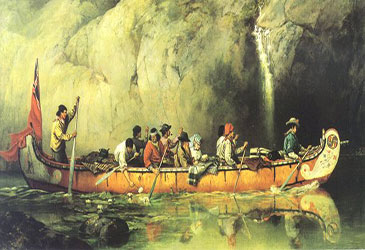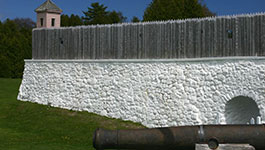All About Northern Michigan History
Northern Michigan is a region of the state of Michigan and forms a large part of the Great Lakes shoreline. It comprises several small to medium-sized cities with a total population of around 506,658 in the 21 northern-most counties of the Lower Peninsula of Michigan. There are numerous lakes and rivers, and extensive state and national forests. Much like other regions in the area, it relies on tourism as its primary industry.
Pre-Colonial Era
 Northern Michigan was inhibited by itinerant Native American cultures for thousands of years before the French and English arrived to set up colonies in the region. Scholars believe the area was occupied by pre-historic inhabitants known as the Laurel Complex which was part of the Hopewell Indian exchange system named after a tribe that existed in the Great Lakes region. They were driven southwest to the Menominee River by invading tribes from the east, and it is recorded that Emmet County was populated by a race called the Mush-co-desh. As they abandoned their worn-out gardens, it was formed into grassy plains, and they shaped the land by making woodland into a prairie. According to Ottawa tradition 40,000 – 50,000 were slaughtered and the rest driven from the area because they insulted an Ottawa war party.
Northern Michigan was inhibited by itinerant Native American cultures for thousands of years before the French and English arrived to set up colonies in the region. Scholars believe the area was occupied by pre-historic inhabitants known as the Laurel Complex which was part of the Hopewell Indian exchange system named after a tribe that existed in the Great Lakes region. They were driven southwest to the Menominee River by invading tribes from the east, and it is recorded that Emmet County was populated by a race called the Mush-co-desh. As they abandoned their worn-out gardens, it was formed into grassy plains, and they shaped the land by making woodland into a prairie. According to Ottawa tradition 40,000 – 50,000 were slaughtered and the rest driven from the area because they insulted an Ottawa war party.
French exploration and Beaver Wars
 Samuel de Champlain established Quebec as part of the New France in 1608 and established a fur trade with Indian tribes. While the French colonized interior lands along the St. Lawrence River, the English and Dutch started to set up fur trades along the east and southeast of the Great Lakes. This resulted in the brutal Beaver Wars.
Samuel de Champlain established Quebec as part of the New France in 1608 and established a fur trade with Indian tribes. While the French colonized interior lands along the St. Lawrence River, the English and Dutch started to set up fur trades along the east and southeast of the Great Lakes. This resulted in the brutal Beaver Wars.
The Jesuit Mission at St. Ignace
.jpg)
In 1671 the Jesuit Father Marquette set up the St. Ignace mission evangelizing the Indians who planted a large cross and established the L’Arbre Croche mission, now known as Harbor Springs. In 1679 Father Louis Hennepin, Sieur de La Salle, and René-Robert Cavelier set out on Le Griffon, the first sailing ship known to sail in Northern Michigan, exploring uncharted waters previously only traversed by men in canoes.
The St. Ignace mission was abandoned and burned down in 1705 but reopened in 1712 operating on the north shore of the Straits until it was relocated to the south shore in 1741. During the First Fox War around 1715, the French re-established a military outpost called Fort Michilimackinac which became the new location for mission work with the natives as well as a fur and other trade.
The beginning of the British Era
After defeating the French, the British took control of the territory east of the Mississippi River. After the majority of the residents were killed by the natives in 1763, the British built the more substantial Fort Mackinac at the site.
The success of the rebels in the American Revolutionary War led to the British formally ceding Fort Mackinac to the newly independent Unites States in 1783 at the Treaty of Paris. Until the 1830s the Americans continued the fur trade and several territorial disputes.
By 1840 the American Fur Company was in steep decline due to silk replacing beaver fur in European fashion. In 1825 the Erie Canal was opened to bring settlers from New York and New England. The opening of the route and the incorporation of Chicago increased the steamboat traffic from Detroit to Chicago. In 1837 Michigan became a state and named Douglass Houghton to lead the Michigan Geological Survey in the area.
Early settlers were fishermen, missionaries, and participants in the early Great Lakes maritime industry. In 1835 Lieutenant Benjamin Poole surveyed a former Indian route between Mackinac and Saginaw that became known as the Mackinac Trail. Principal fishing settlements included Fishtown in Michigan, Leland, and the Beaver Island Archipelago. Early Northern Michigan lighthouses were built between 1831 and 1858.
 After the land had been surveyed and native land claims eliminated, the Homestead Act of 1862 allowed many Civil War veterans and speculators to acquire 160-acre land tracts. Woodcutting for passing ships morphed into a full lumber industry that contributed to the rise of port cities like Traverse City, Manistee, Ludington, and Charlevoix. In 1870 the railroad was built. The Flint and Pere Marquette Railroad had a terminal at Ludington in 1874, and the Michigan Central Railroad traveled to Otsego County. For several years the rail investment declined due to the financial panic of 1873 bring about an economic slowdown lasting 5 years during which Mackinaw City and Cheboygan did not have any rail services.
After the land had been surveyed and native land claims eliminated, the Homestead Act of 1862 allowed many Civil War veterans and speculators to acquire 160-acre land tracts. Woodcutting for passing ships morphed into a full lumber industry that contributed to the rise of port cities like Traverse City, Manistee, Ludington, and Charlevoix. In 1870 the railroad was built. The Flint and Pere Marquette Railroad had a terminal at Ludington in 1874, and the Michigan Central Railroad traveled to Otsego County. For several years the rail investment declined due to the financial panic of 1873 bring about an economic slowdown lasting 5 years during which Mackinaw City and Cheboygan did not have any rail services.
Despite the Great Michigan Fire in Manistee in 1871, lumbering increased with new machine tools that were steam powered and circular saws and sawmills that could quickly process high volumes of lumber. By the 1880s the Great Lakes region dominated logging and Michigan was producing more lumber than any other US state. During the 1880s the commercial fishing industry in Beaver Island became the largest supplier of fish in the United States.
